Business Decision Making: Employee Productivity and Smartphone Usage
VerifiedAdded on 2023/06/03
|24
|4382
|328
Report
AI Summary
This report examines the impact of smartphone usage on employee productivity and organizational culture, highlighting both positive and negative influences. It uses primary data collected through surveys from employees in telecommunication, banking, and hospitality industries, alongside secondary data from governmental websites and scholarly publications. The research explores how smartphones facilitate remote communication and task performance, but also contribute to decreased productivity due to distractions and potential addiction. Data analysis reveals correlations between smartphone usage and various work-related activities, providing insights into the extent of personal calls, internet usage, and perceived benefits of smartphones in the workplace. The report concludes by emphasizing the need for organizations to manage smartphone usage effectively to maximize benefits while mitigating negative impacts on productivity and safety.
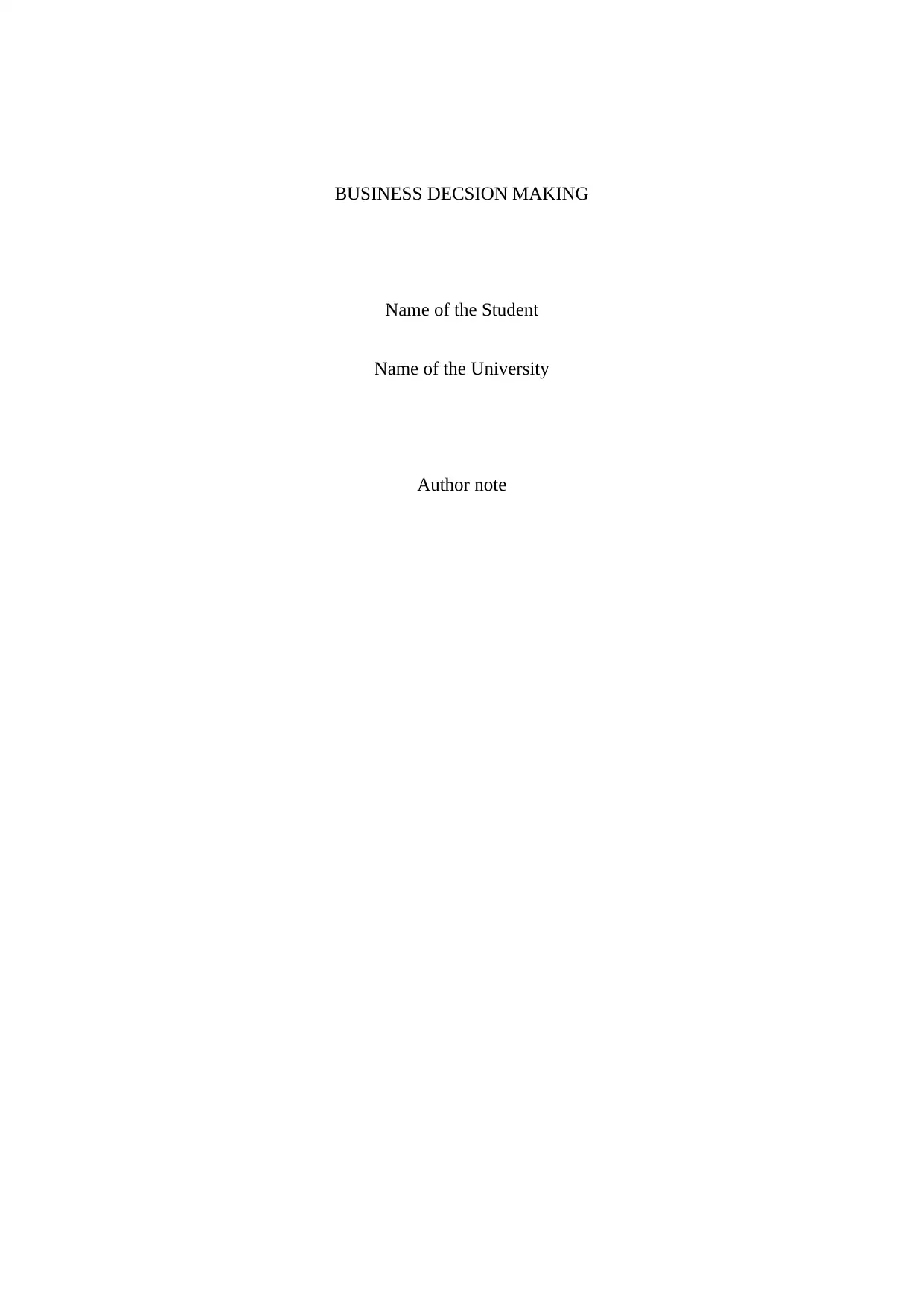
BUSINESS DECSION MAKING
Name of the Student
Name of the University
Author note
Name of the Student
Name of the University
Author note
Paraphrase This Document
Need a fresh take? Get an instant paraphrase of this document with our AI Paraphraser
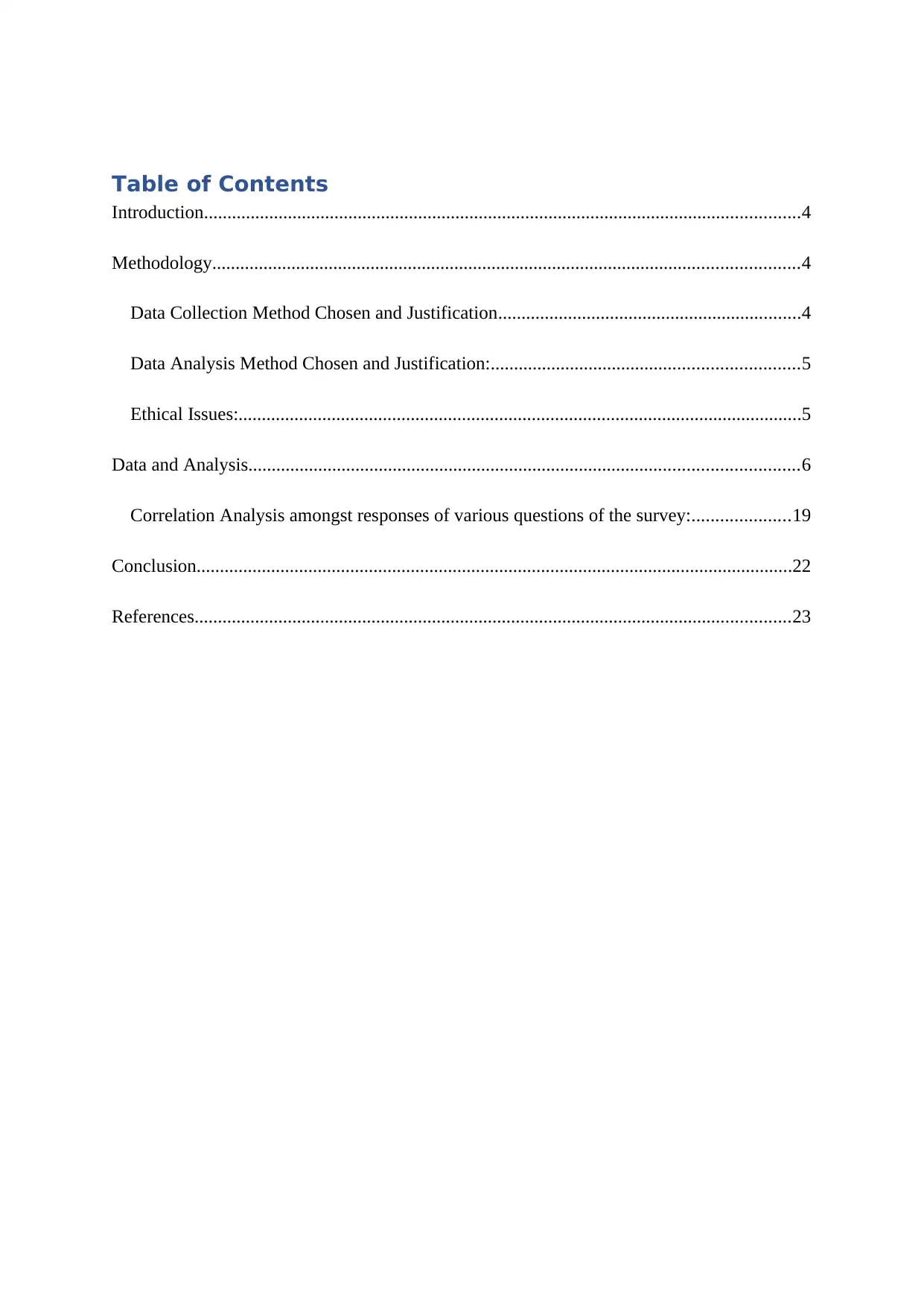
Table of Contents
Introduction................................................................................................................................4
Methodology..............................................................................................................................4
Data Collection Method Chosen and Justification.................................................................4
Data Analysis Method Chosen and Justification:..................................................................5
Ethical Issues:.........................................................................................................................5
Data and Analysis......................................................................................................................6
Correlation Analysis amongst responses of various questions of the survey:.....................19
Conclusion................................................................................................................................22
References................................................................................................................................23
Introduction................................................................................................................................4
Methodology..............................................................................................................................4
Data Collection Method Chosen and Justification.................................................................4
Data Analysis Method Chosen and Justification:..................................................................5
Ethical Issues:.........................................................................................................................5
Data and Analysis......................................................................................................................6
Correlation Analysis amongst responses of various questions of the survey:.....................19
Conclusion................................................................................................................................22
References................................................................................................................................23
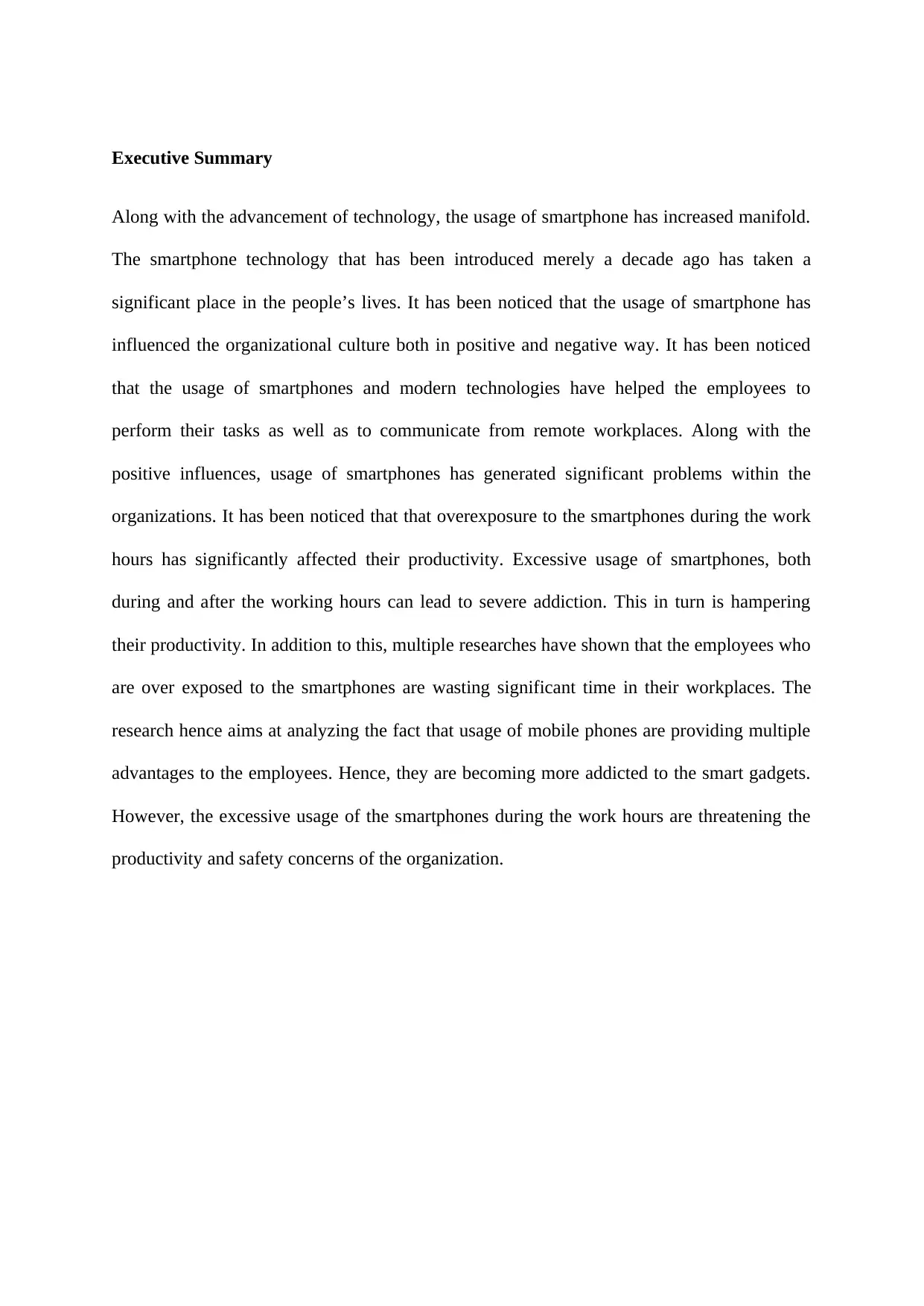
Executive Summary
Along with the advancement of technology, the usage of smartphone has increased manifold.
The smartphone technology that has been introduced merely a decade ago has taken a
significant place in the people’s lives. It has been noticed that the usage of smartphone has
influenced the organizational culture both in positive and negative way. It has been noticed
that the usage of smartphones and modern technologies have helped the employees to
perform their tasks as well as to communicate from remote workplaces. Along with the
positive influences, usage of smartphones has generated significant problems within the
organizations. It has been noticed that that overexposure to the smartphones during the work
hours has significantly affected their productivity. Excessive usage of smartphones, both
during and after the working hours can lead to severe addiction. This in turn is hampering
their productivity. In addition to this, multiple researches have shown that the employees who
are over exposed to the smartphones are wasting significant time in their workplaces. The
research hence aims at analyzing the fact that usage of mobile phones are providing multiple
advantages to the employees. Hence, they are becoming more addicted to the smart gadgets.
However, the excessive usage of the smartphones during the work hours are threatening the
productivity and safety concerns of the organization.
Along with the advancement of technology, the usage of smartphone has increased manifold.
The smartphone technology that has been introduced merely a decade ago has taken a
significant place in the people’s lives. It has been noticed that the usage of smartphone has
influenced the organizational culture both in positive and negative way. It has been noticed
that the usage of smartphones and modern technologies have helped the employees to
perform their tasks as well as to communicate from remote workplaces. Along with the
positive influences, usage of smartphones has generated significant problems within the
organizations. It has been noticed that that overexposure to the smartphones during the work
hours has significantly affected their productivity. Excessive usage of smartphones, both
during and after the working hours can lead to severe addiction. This in turn is hampering
their productivity. In addition to this, multiple researches have shown that the employees who
are over exposed to the smartphones are wasting significant time in their workplaces. The
research hence aims at analyzing the fact that usage of mobile phones are providing multiple
advantages to the employees. Hence, they are becoming more addicted to the smart gadgets.
However, the excessive usage of the smartphones during the work hours are threatening the
productivity and safety concerns of the organization.
⊘ This is a preview!⊘
Do you want full access?
Subscribe today to unlock all pages.

Trusted by 1+ million students worldwide
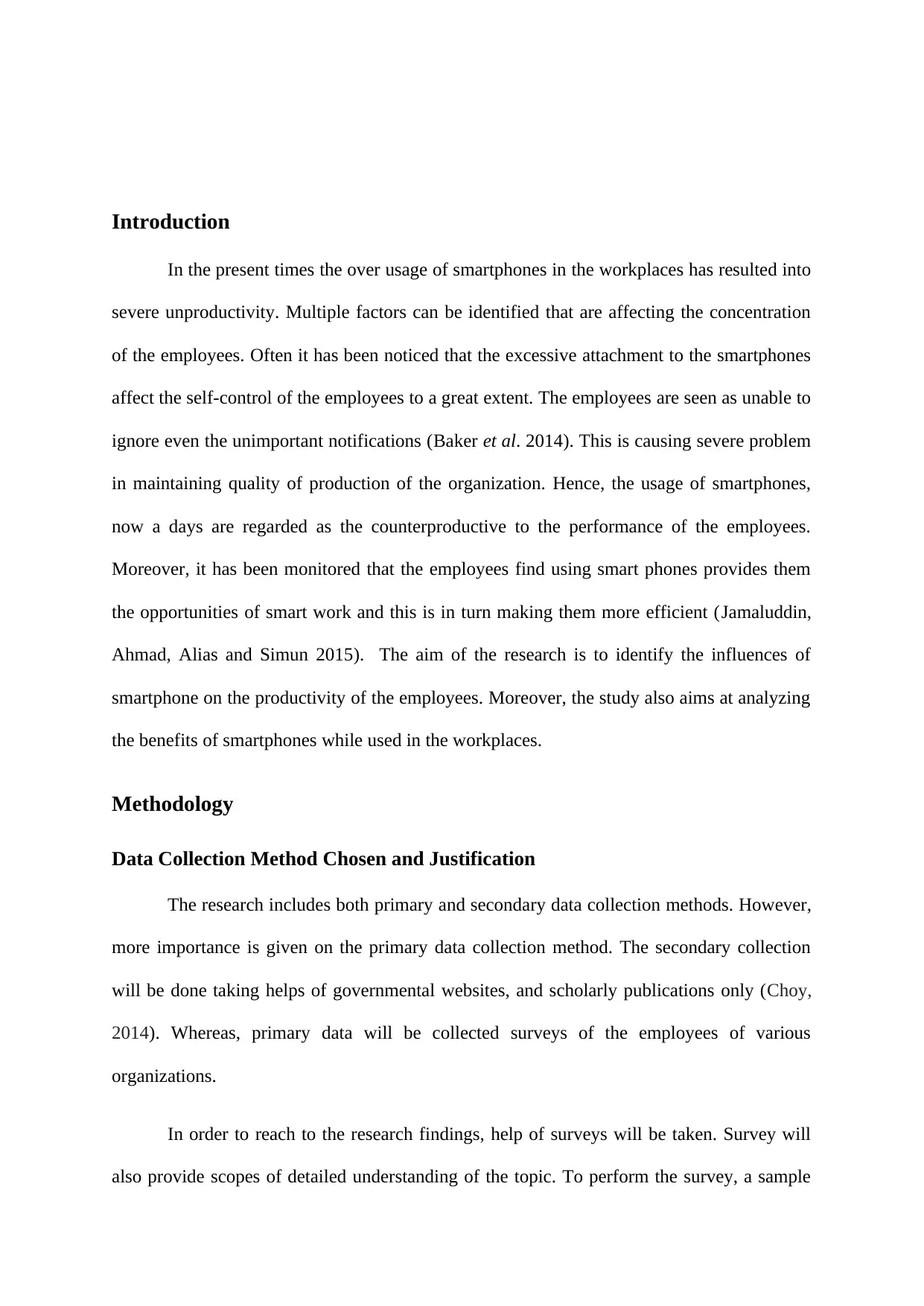
Introduction
In the present times the over usage of smartphones in the workplaces has resulted into
severe unproductivity. Multiple factors can be identified that are affecting the concentration
of the employees. Often it has been noticed that the excessive attachment to the smartphones
affect the self-control of the employees to a great extent. The employees are seen as unable to
ignore even the unimportant notifications (Baker et al. 2014). This is causing severe problem
in maintaining quality of production of the organization. Hence, the usage of smartphones,
now a days are regarded as the counterproductive to the performance of the employees.
Moreover, it has been monitored that the employees find using smart phones provides them
the opportunities of smart work and this is in turn making them more efficient (Jamaluddin,
Ahmad, Alias and Simun 2015). The aim of the research is to identify the influences of
smartphone on the productivity of the employees. Moreover, the study also aims at analyzing
the benefits of smartphones while used in the workplaces.
Methodology
Data Collection Method Chosen and Justification
The research includes both primary and secondary data collection methods. However,
more importance is given on the primary data collection method. The secondary collection
will be done taking helps of governmental websites, and scholarly publications only (Choy,
2014). Whereas, primary data will be collected surveys of the employees of various
organizations.
In order to reach to the research findings, help of surveys will be taken. Survey will
also provide scopes of detailed understanding of the topic. To perform the survey, a sample
In the present times the over usage of smartphones in the workplaces has resulted into
severe unproductivity. Multiple factors can be identified that are affecting the concentration
of the employees. Often it has been noticed that the excessive attachment to the smartphones
affect the self-control of the employees to a great extent. The employees are seen as unable to
ignore even the unimportant notifications (Baker et al. 2014). This is causing severe problem
in maintaining quality of production of the organization. Hence, the usage of smartphones,
now a days are regarded as the counterproductive to the performance of the employees.
Moreover, it has been monitored that the employees find using smart phones provides them
the opportunities of smart work and this is in turn making them more efficient (Jamaluddin,
Ahmad, Alias and Simun 2015). The aim of the research is to identify the influences of
smartphone on the productivity of the employees. Moreover, the study also aims at analyzing
the benefits of smartphones while used in the workplaces.
Methodology
Data Collection Method Chosen and Justification
The research includes both primary and secondary data collection methods. However,
more importance is given on the primary data collection method. The secondary collection
will be done taking helps of governmental websites, and scholarly publications only (Choy,
2014). Whereas, primary data will be collected surveys of the employees of various
organizations.
In order to reach to the research findings, help of surveys will be taken. Survey will
also provide scopes of detailed understanding of the topic. To perform the survey, a sample
Paraphrase This Document
Need a fresh take? Get an instant paraphrase of this document with our AI Paraphraser
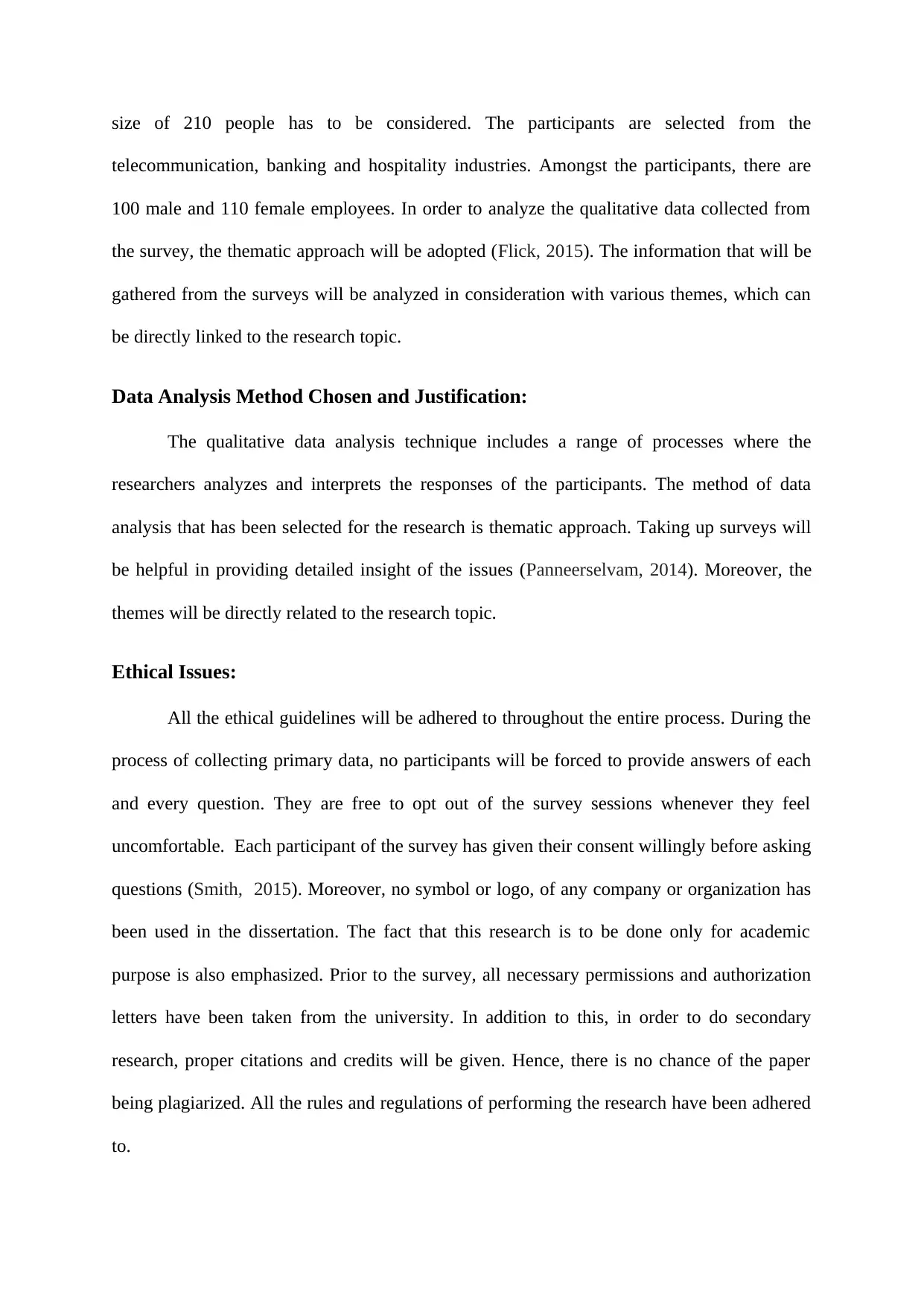
size of 210 people has to be considered. The participants are selected from the
telecommunication, banking and hospitality industries. Amongst the participants, there are
100 male and 110 female employees. In order to analyze the qualitative data collected from
the survey, the thematic approach will be adopted (Flick, 2015). The information that will be
gathered from the surveys will be analyzed in consideration with various themes, which can
be directly linked to the research topic.
Data Analysis Method Chosen and Justification:
The qualitative data analysis technique includes a range of processes where the
researchers analyzes and interprets the responses of the participants. The method of data
analysis that has been selected for the research is thematic approach. Taking up surveys will
be helpful in providing detailed insight of the issues (Panneerselvam, 2014). Moreover, the
themes will be directly related to the research topic.
Ethical Issues:
All the ethical guidelines will be adhered to throughout the entire process. During the
process of collecting primary data, no participants will be forced to provide answers of each
and every question. They are free to opt out of the survey sessions whenever they feel
uncomfortable. Each participant of the survey has given their consent willingly before asking
questions (Smith, 2015). Moreover, no symbol or logo, of any company or organization has
been used in the dissertation. The fact that this research is to be done only for academic
purpose is also emphasized. Prior to the survey, all necessary permissions and authorization
letters have been taken from the university. In addition to this, in order to do secondary
research, proper citations and credits will be given. Hence, there is no chance of the paper
being plagiarized. All the rules and regulations of performing the research have been adhered
to.
telecommunication, banking and hospitality industries. Amongst the participants, there are
100 male and 110 female employees. In order to analyze the qualitative data collected from
the survey, the thematic approach will be adopted (Flick, 2015). The information that will be
gathered from the surveys will be analyzed in consideration with various themes, which can
be directly linked to the research topic.
Data Analysis Method Chosen and Justification:
The qualitative data analysis technique includes a range of processes where the
researchers analyzes and interprets the responses of the participants. The method of data
analysis that has been selected for the research is thematic approach. Taking up surveys will
be helpful in providing detailed insight of the issues (Panneerselvam, 2014). Moreover, the
themes will be directly related to the research topic.
Ethical Issues:
All the ethical guidelines will be adhered to throughout the entire process. During the
process of collecting primary data, no participants will be forced to provide answers of each
and every question. They are free to opt out of the survey sessions whenever they feel
uncomfortable. Each participant of the survey has given their consent willingly before asking
questions (Smith, 2015). Moreover, no symbol or logo, of any company or organization has
been used in the dissertation. The fact that this research is to be done only for academic
purpose is also emphasized. Prior to the survey, all necessary permissions and authorization
letters have been taken from the university. In addition to this, in order to do secondary
research, proper citations and credits will be given. Hence, there is no chance of the paper
being plagiarized. All the rules and regulations of performing the research have been adhered
to.
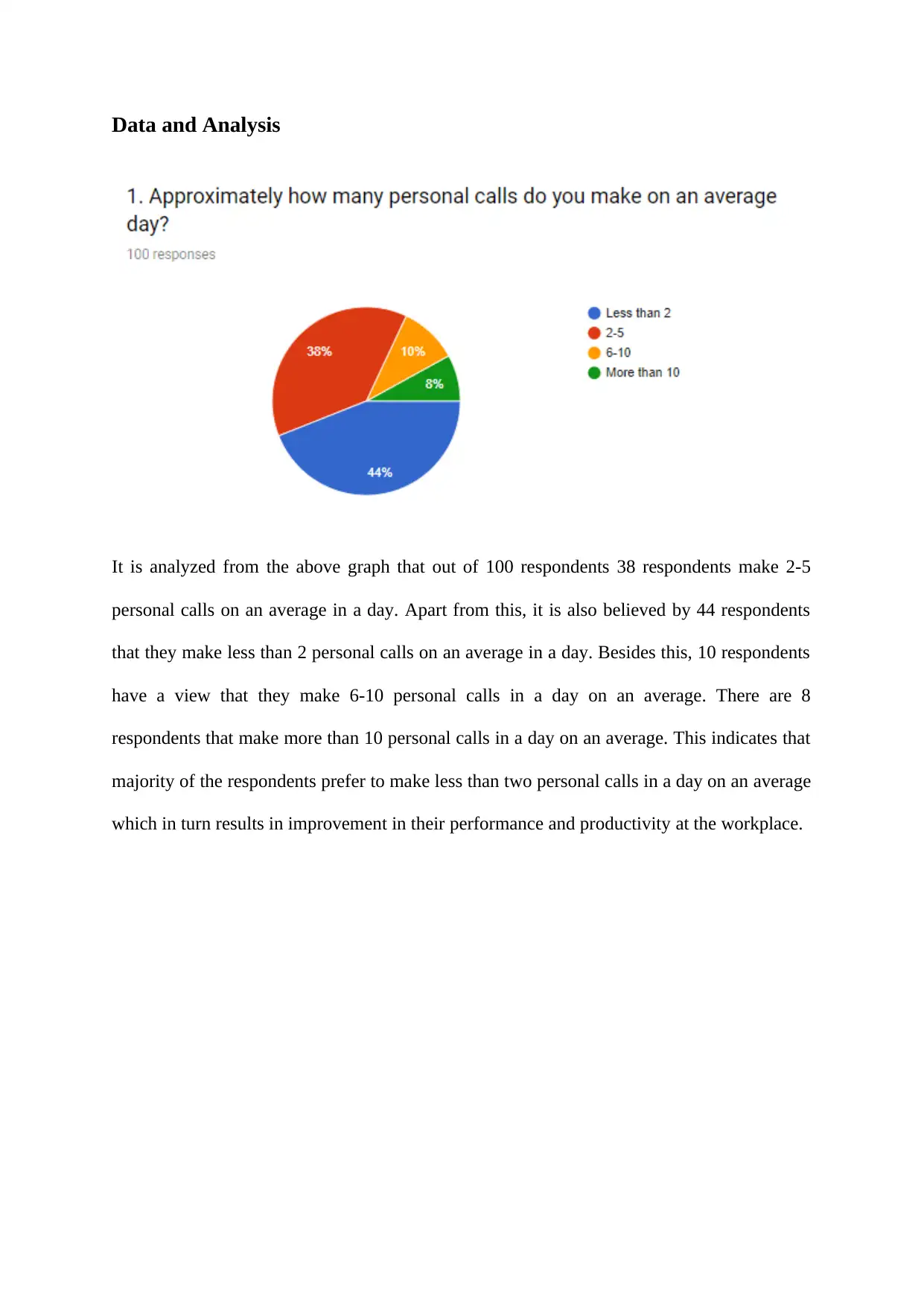
Data and Analysis
It is analyzed from the above graph that out of 100 respondents 38 respondents make 2-5
personal calls on an average in a day. Apart from this, it is also believed by 44 respondents
that they make less than 2 personal calls on an average in a day. Besides this, 10 respondents
have a view that they make 6-10 personal calls in a day on an average. There are 8
respondents that make more than 10 personal calls in a day on an average. This indicates that
majority of the respondents prefer to make less than two personal calls in a day on an average
which in turn results in improvement in their performance and productivity at the workplace.
It is analyzed from the above graph that out of 100 respondents 38 respondents make 2-5
personal calls on an average in a day. Apart from this, it is also believed by 44 respondents
that they make less than 2 personal calls on an average in a day. Besides this, 10 respondents
have a view that they make 6-10 personal calls in a day on an average. There are 8
respondents that make more than 10 personal calls in a day on an average. This indicates that
majority of the respondents prefer to make less than two personal calls in a day on an average
which in turn results in improvement in their performance and productivity at the workplace.
⊘ This is a preview!⊘
Do you want full access?
Subscribe today to unlock all pages.

Trusted by 1+ million students worldwide
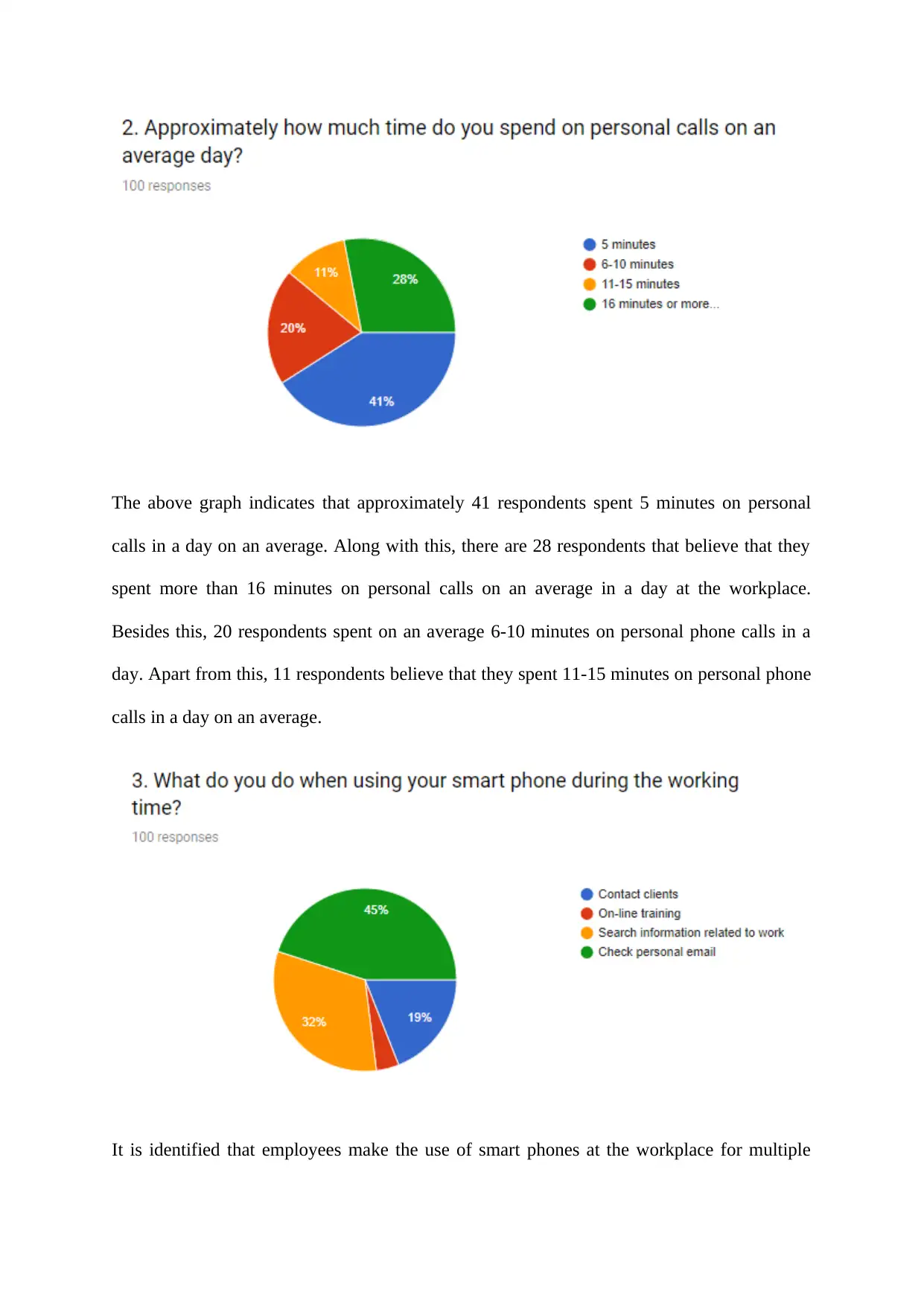
The above graph indicates that approximately 41 respondents spent 5 minutes on personal
calls in a day on an average. Along with this, there are 28 respondents that believe that they
spent more than 16 minutes on personal calls on an average in a day at the workplace.
Besides this, 20 respondents spent on an average 6-10 minutes on personal phone calls in a
day. Apart from this, 11 respondents believe that they spent 11-15 minutes on personal phone
calls in a day on an average.
It is identified that employees make the use of smart phones at the workplace for multiple
calls in a day on an average. Along with this, there are 28 respondents that believe that they
spent more than 16 minutes on personal calls on an average in a day at the workplace.
Besides this, 20 respondents spent on an average 6-10 minutes on personal phone calls in a
day. Apart from this, 11 respondents believe that they spent 11-15 minutes on personal phone
calls in a day on an average.
It is identified that employees make the use of smart phones at the workplace for multiple
Paraphrase This Document
Need a fresh take? Get an instant paraphrase of this document with our AI Paraphraser
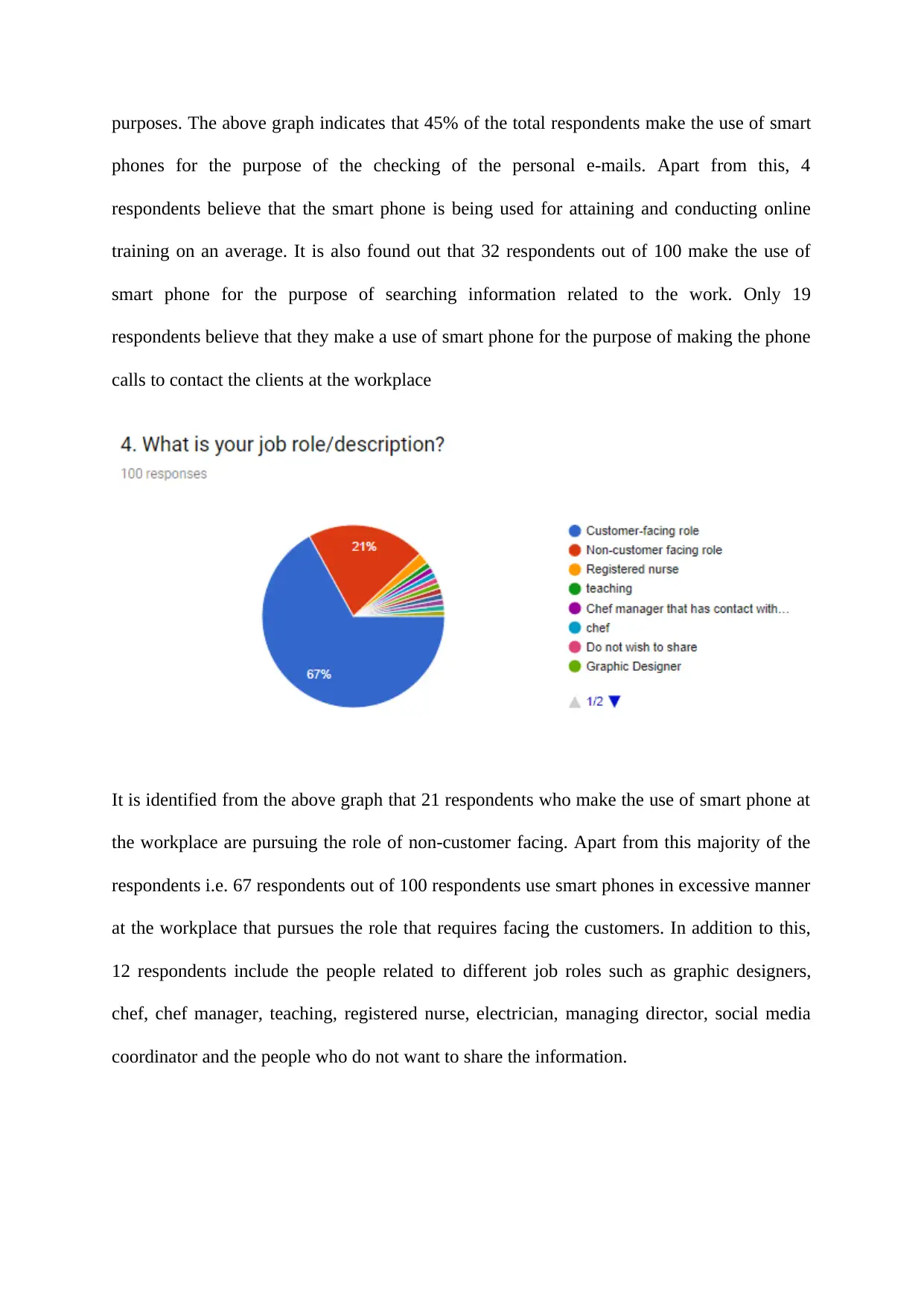
purposes. The above graph indicates that 45% of the total respondents make the use of smart
phones for the purpose of the checking of the personal e-mails. Apart from this, 4
respondents believe that the smart phone is being used for attaining and conducting online
training on an average. It is also found out that 32 respondents out of 100 make the use of
smart phone for the purpose of searching information related to the work. Only 19
respondents believe that they make a use of smart phone for the purpose of making the phone
calls to contact the clients at the workplace
It is identified from the above graph that 21 respondents who make the use of smart phone at
the workplace are pursuing the role of non-customer facing. Apart from this majority of the
respondents i.e. 67 respondents out of 100 respondents use smart phones in excessive manner
at the workplace that pursues the role that requires facing the customers. In addition to this,
12 respondents include the people related to different job roles such as graphic designers,
chef, chef manager, teaching, registered nurse, electrician, managing director, social media
coordinator and the people who do not want to share the information.
phones for the purpose of the checking of the personal e-mails. Apart from this, 4
respondents believe that the smart phone is being used for attaining and conducting online
training on an average. It is also found out that 32 respondents out of 100 make the use of
smart phone for the purpose of searching information related to the work. Only 19
respondents believe that they make a use of smart phone for the purpose of making the phone
calls to contact the clients at the workplace
It is identified from the above graph that 21 respondents who make the use of smart phone at
the workplace are pursuing the role of non-customer facing. Apart from this majority of the
respondents i.e. 67 respondents out of 100 respondents use smart phones in excessive manner
at the workplace that pursues the role that requires facing the customers. In addition to this,
12 respondents include the people related to different job roles such as graphic designers,
chef, chef manager, teaching, registered nurse, electrician, managing director, social media
coordinator and the people who do not want to share the information.
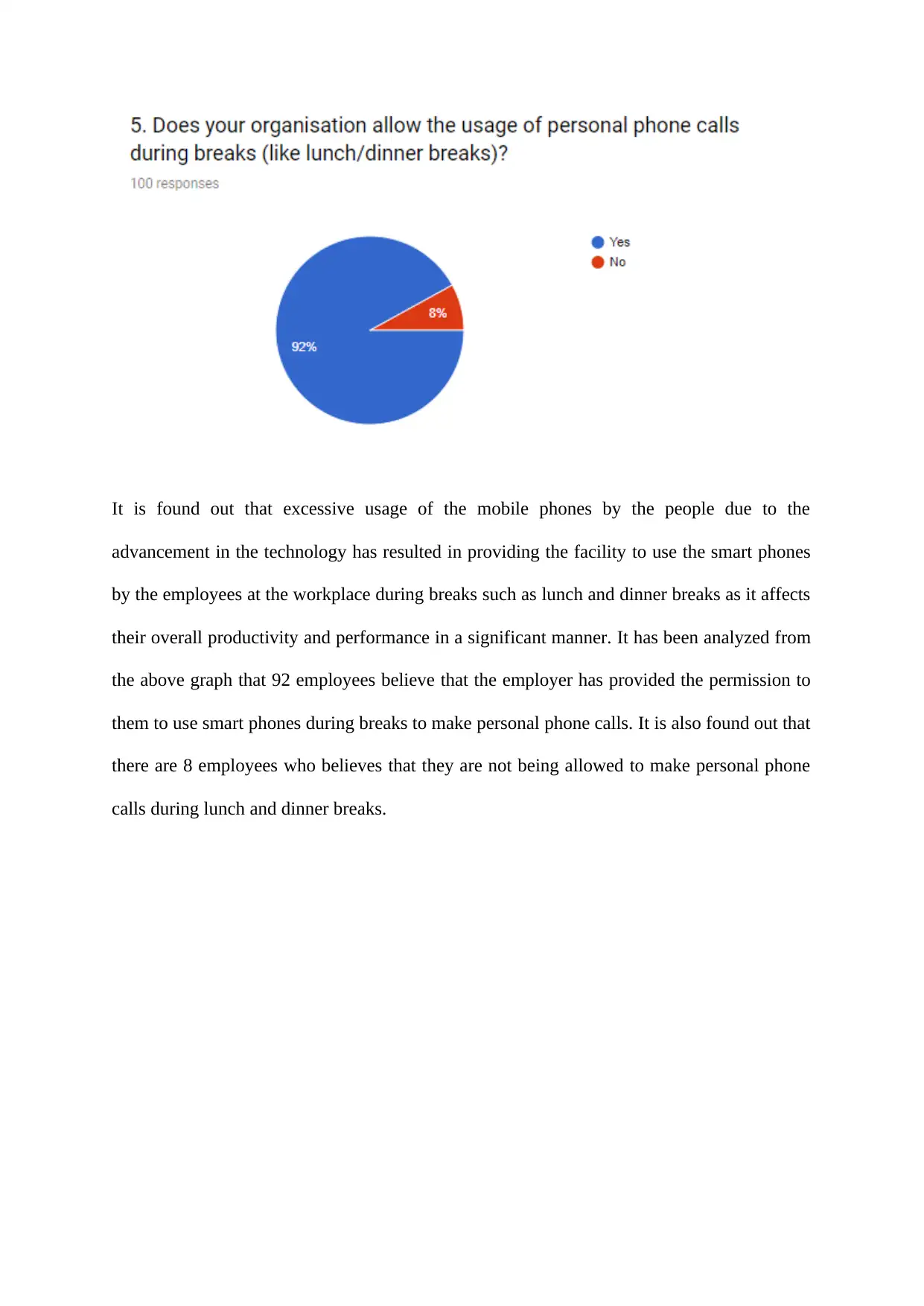
It is found out that excessive usage of the mobile phones by the people due to the
advancement in the technology has resulted in providing the facility to use the smart phones
by the employees at the workplace during breaks such as lunch and dinner breaks as it affects
their overall productivity and performance in a significant manner. It has been analyzed from
the above graph that 92 employees believe that the employer has provided the permission to
them to use smart phones during breaks to make personal phone calls. It is also found out that
there are 8 employees who believes that they are not being allowed to make personal phone
calls during lunch and dinner breaks.
advancement in the technology has resulted in providing the facility to use the smart phones
by the employees at the workplace during breaks such as lunch and dinner breaks as it affects
their overall productivity and performance in a significant manner. It has been analyzed from
the above graph that 92 employees believe that the employer has provided the permission to
them to use smart phones during breaks to make personal phone calls. It is also found out that
there are 8 employees who believes that they are not being allowed to make personal phone
calls during lunch and dinner breaks.
⊘ This is a preview!⊘
Do you want full access?
Subscribe today to unlock all pages.

Trusted by 1+ million students worldwide
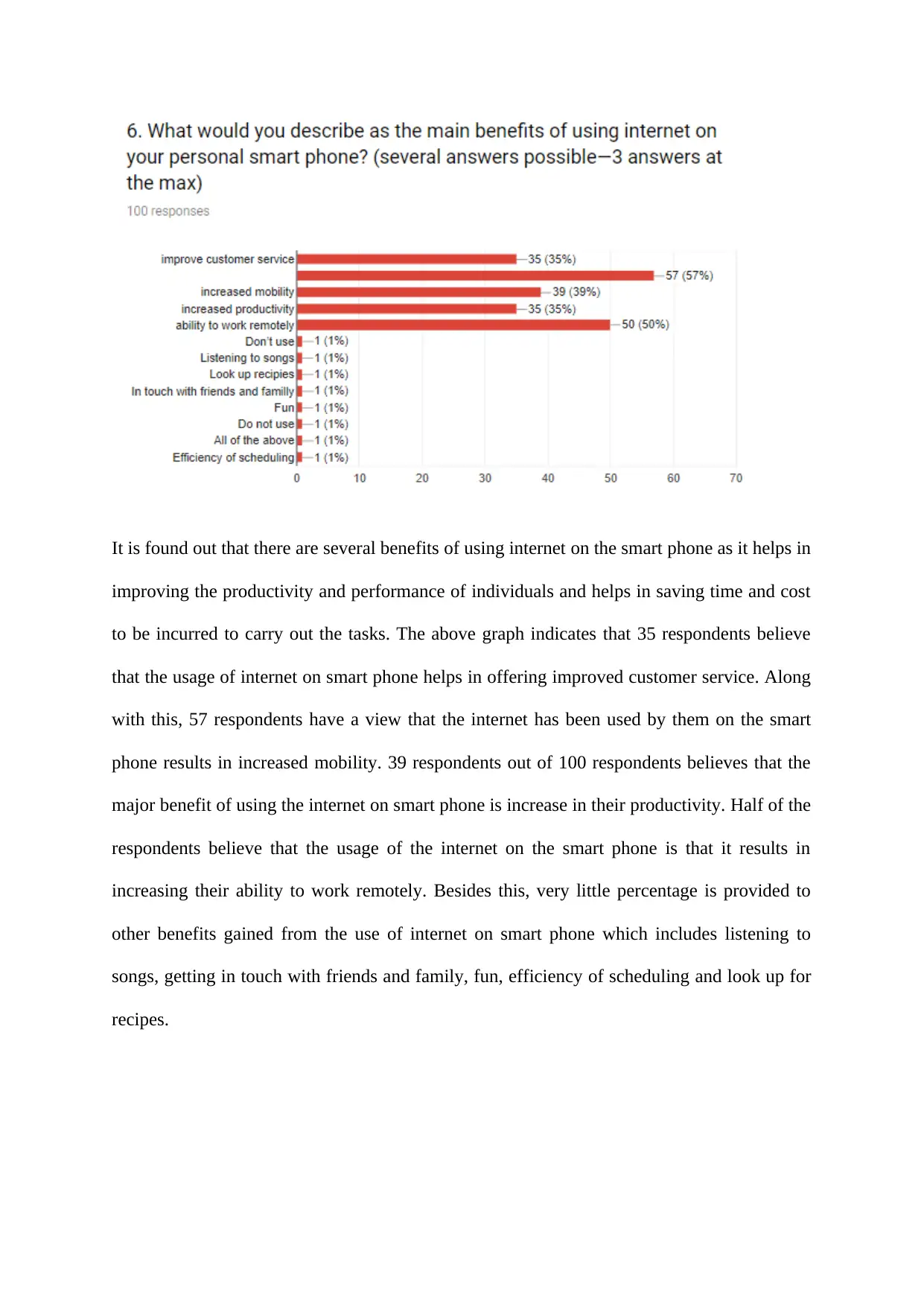
It is found out that there are several benefits of using internet on the smart phone as it helps in
improving the productivity and performance of individuals and helps in saving time and cost
to be incurred to carry out the tasks. The above graph indicates that 35 respondents believe
that the usage of internet on smart phone helps in offering improved customer service. Along
with this, 57 respondents have a view that the internet has been used by them on the smart
phone results in increased mobility. 39 respondents out of 100 respondents believes that the
major benefit of using the internet on smart phone is increase in their productivity. Half of the
respondents believe that the usage of the internet on the smart phone is that it results in
increasing their ability to work remotely. Besides this, very little percentage is provided to
other benefits gained from the use of internet on smart phone which includes listening to
songs, getting in touch with friends and family, fun, efficiency of scheduling and look up for
recipes.
improving the productivity and performance of individuals and helps in saving time and cost
to be incurred to carry out the tasks. The above graph indicates that 35 respondents believe
that the usage of internet on smart phone helps in offering improved customer service. Along
with this, 57 respondents have a view that the internet has been used by them on the smart
phone results in increased mobility. 39 respondents out of 100 respondents believes that the
major benefit of using the internet on smart phone is increase in their productivity. Half of the
respondents believe that the usage of the internet on the smart phone is that it results in
increasing their ability to work remotely. Besides this, very little percentage is provided to
other benefits gained from the use of internet on smart phone which includes listening to
songs, getting in touch with friends and family, fun, efficiency of scheduling and look up for
recipes.
Paraphrase This Document
Need a fresh take? Get an instant paraphrase of this document with our AI Paraphraser
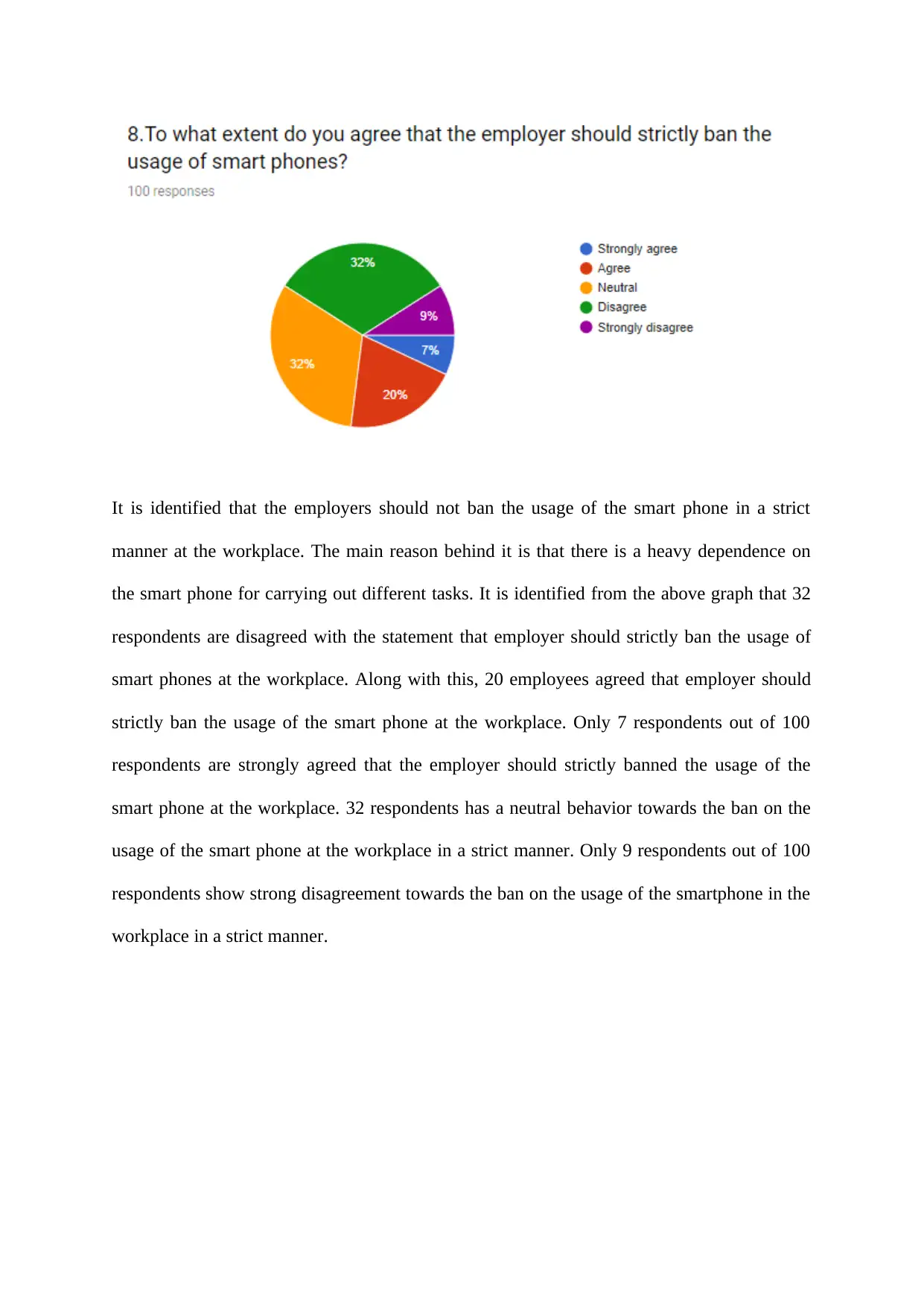
It is identified that the employers should not ban the usage of the smart phone in a strict
manner at the workplace. The main reason behind it is that there is a heavy dependence on
the smart phone for carrying out different tasks. It is identified from the above graph that 32
respondents are disagreed with the statement that employer should strictly ban the usage of
smart phones at the workplace. Along with this, 20 employees agreed that employer should
strictly ban the usage of the smart phone at the workplace. Only 7 respondents out of 100
respondents are strongly agreed that the employer should strictly banned the usage of the
smart phone at the workplace. 32 respondents has a neutral behavior towards the ban on the
usage of the smart phone at the workplace in a strict manner. Only 9 respondents out of 100
respondents show strong disagreement towards the ban on the usage of the smartphone in the
workplace in a strict manner.
manner at the workplace. The main reason behind it is that there is a heavy dependence on
the smart phone for carrying out different tasks. It is identified from the above graph that 32
respondents are disagreed with the statement that employer should strictly ban the usage of
smart phones at the workplace. Along with this, 20 employees agreed that employer should
strictly ban the usage of the smart phone at the workplace. Only 7 respondents out of 100
respondents are strongly agreed that the employer should strictly banned the usage of the
smart phone at the workplace. 32 respondents has a neutral behavior towards the ban on the
usage of the smart phone at the workplace in a strict manner. Only 9 respondents out of 100
respondents show strong disagreement towards the ban on the usage of the smartphone in the
workplace in a strict manner.
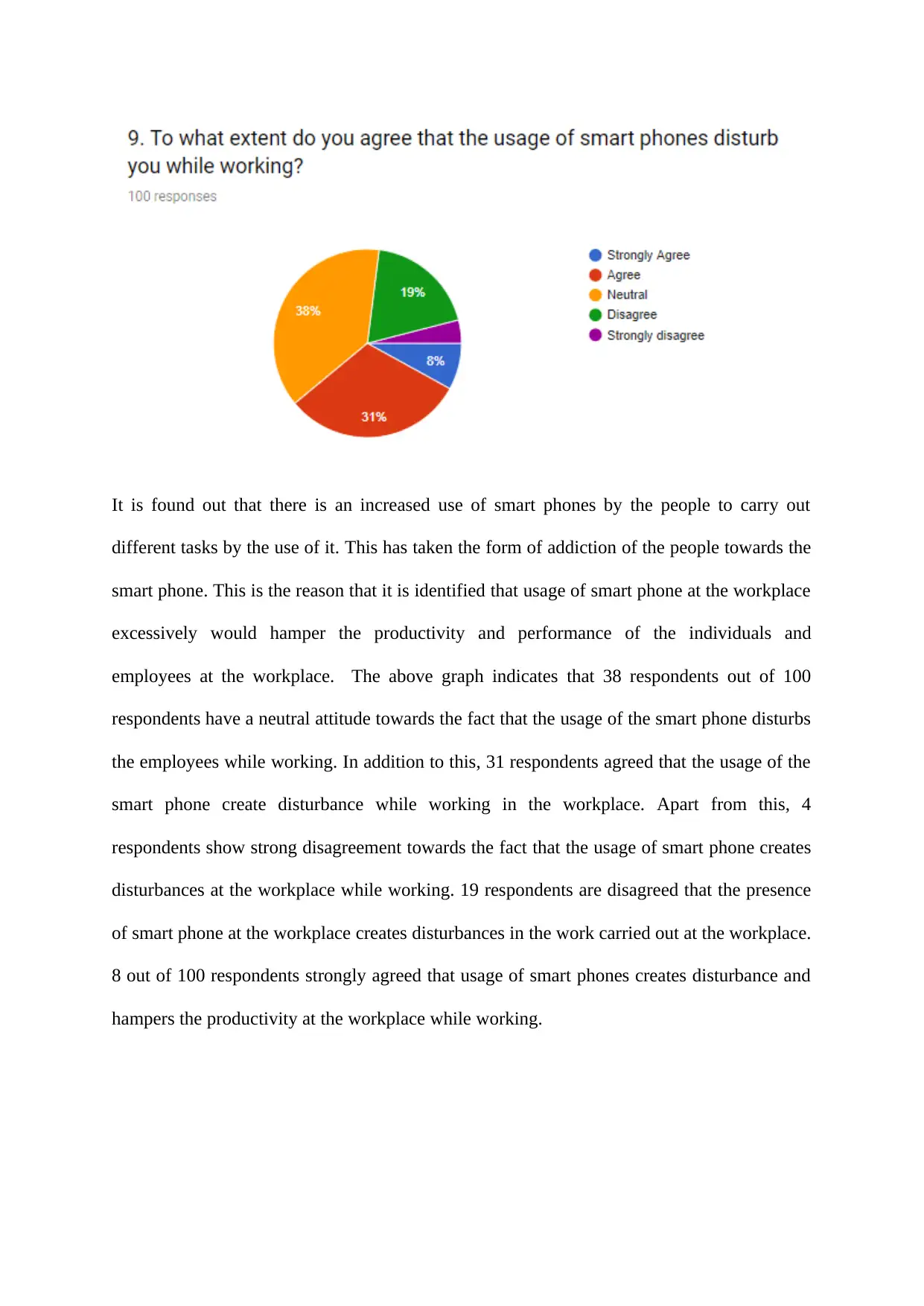
It is found out that there is an increased use of smart phones by the people to carry out
different tasks by the use of it. This has taken the form of addiction of the people towards the
smart phone. This is the reason that it is identified that usage of smart phone at the workplace
excessively would hamper the productivity and performance of the individuals and
employees at the workplace. The above graph indicates that 38 respondents out of 100
respondents have a neutral attitude towards the fact that the usage of the smart phone disturbs
the employees while working. In addition to this, 31 respondents agreed that the usage of the
smart phone create disturbance while working in the workplace. Apart from this, 4
respondents show strong disagreement towards the fact that the usage of smart phone creates
disturbances at the workplace while working. 19 respondents are disagreed that the presence
of smart phone at the workplace creates disturbances in the work carried out at the workplace.
8 out of 100 respondents strongly agreed that usage of smart phones creates disturbance and
hampers the productivity at the workplace while working.
different tasks by the use of it. This has taken the form of addiction of the people towards the
smart phone. This is the reason that it is identified that usage of smart phone at the workplace
excessively would hamper the productivity and performance of the individuals and
employees at the workplace. The above graph indicates that 38 respondents out of 100
respondents have a neutral attitude towards the fact that the usage of the smart phone disturbs
the employees while working. In addition to this, 31 respondents agreed that the usage of the
smart phone create disturbance while working in the workplace. Apart from this, 4
respondents show strong disagreement towards the fact that the usage of smart phone creates
disturbances at the workplace while working. 19 respondents are disagreed that the presence
of smart phone at the workplace creates disturbances in the work carried out at the workplace.
8 out of 100 respondents strongly agreed that usage of smart phones creates disturbance and
hampers the productivity at the workplace while working.
⊘ This is a preview!⊘
Do you want full access?
Subscribe today to unlock all pages.

Trusted by 1+ million students worldwide
1 out of 24
Related Documents
Your All-in-One AI-Powered Toolkit for Academic Success.
+13062052269
info@desklib.com
Available 24*7 on WhatsApp / Email
![[object Object]](/_next/static/media/star-bottom.7253800d.svg)
Unlock your academic potential
Copyright © 2020–2025 A2Z Services. All Rights Reserved. Developed and managed by ZUCOL.


